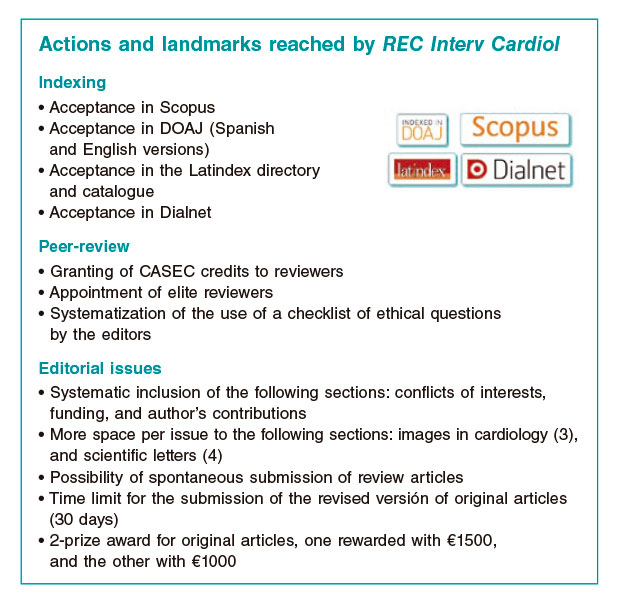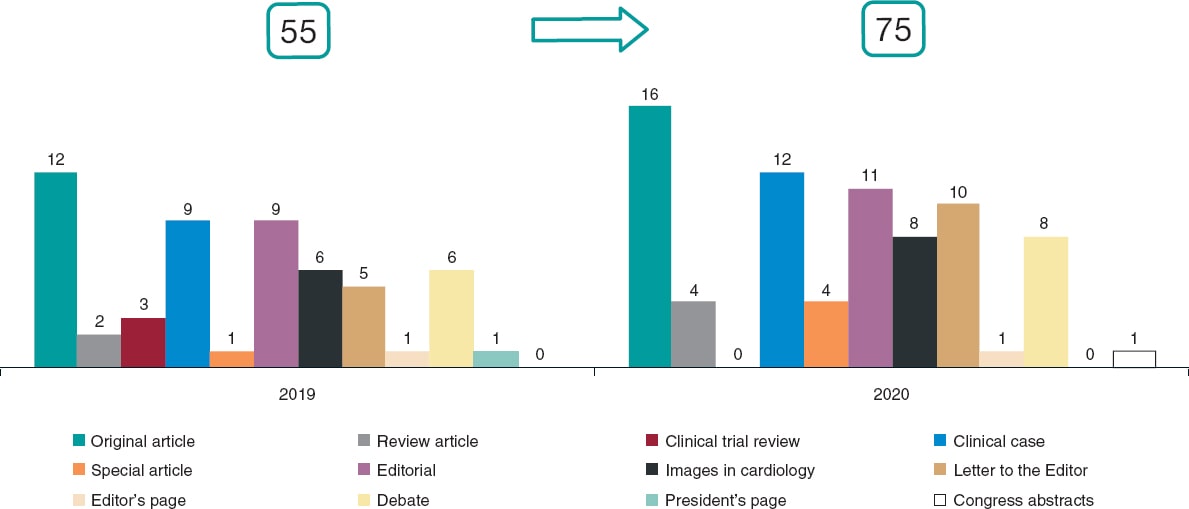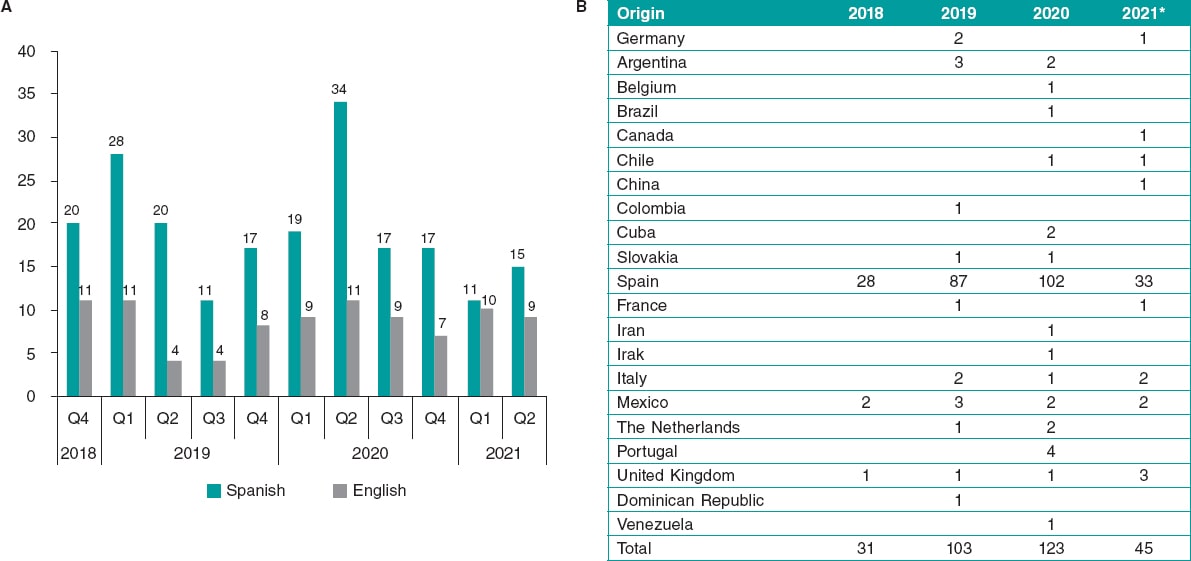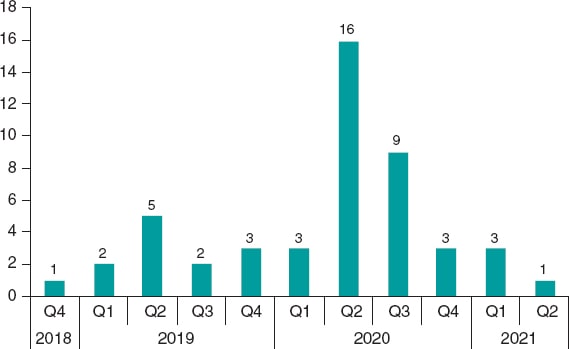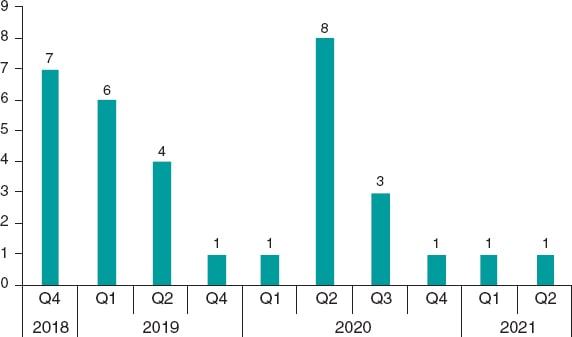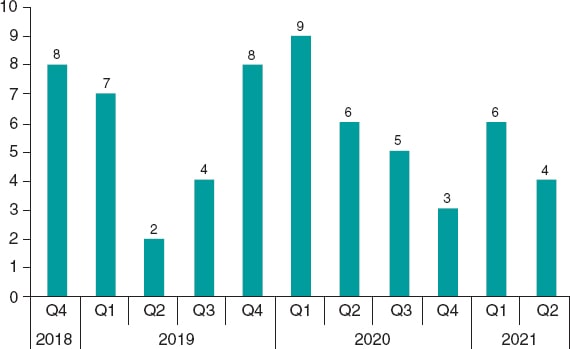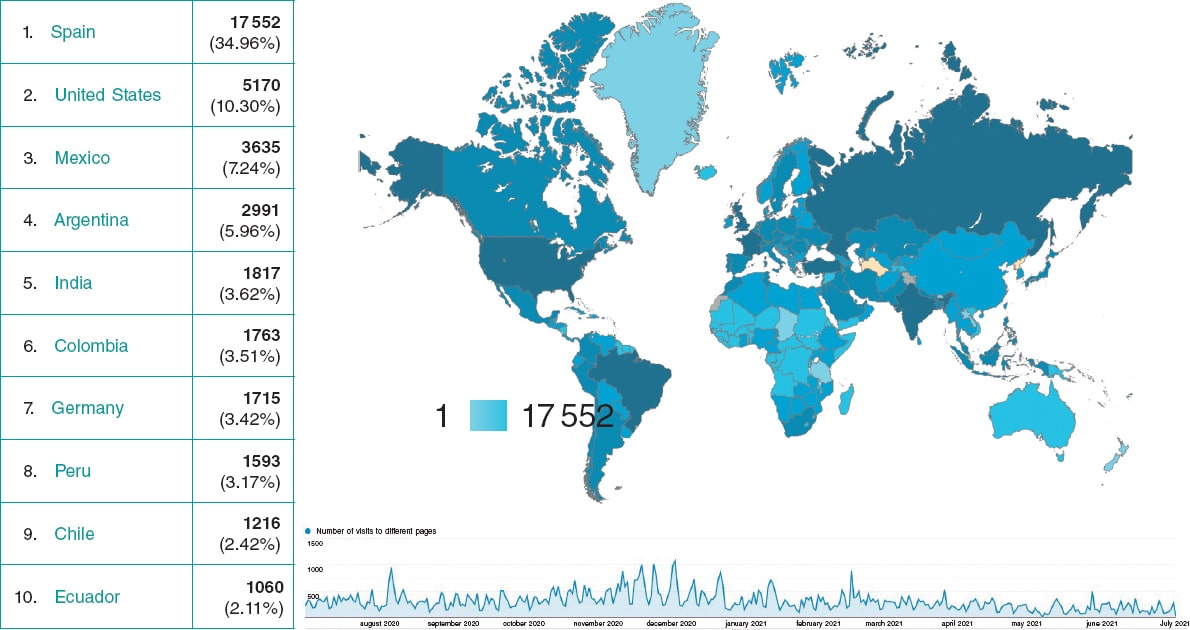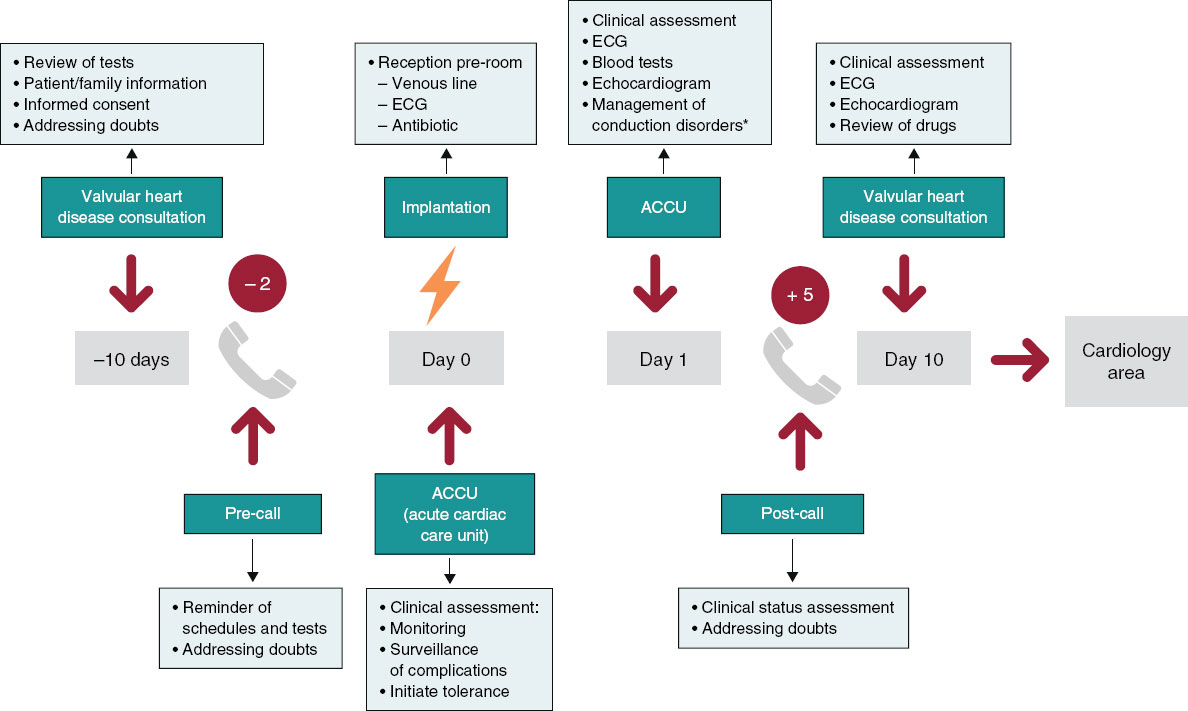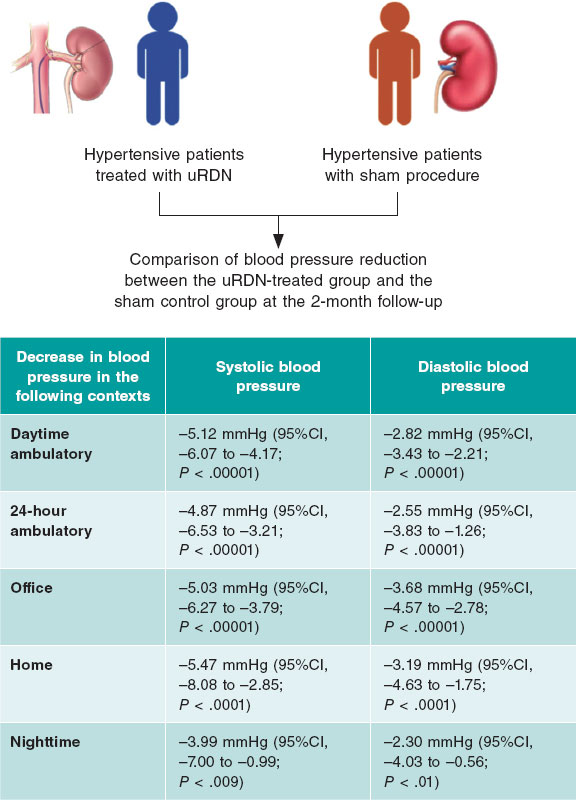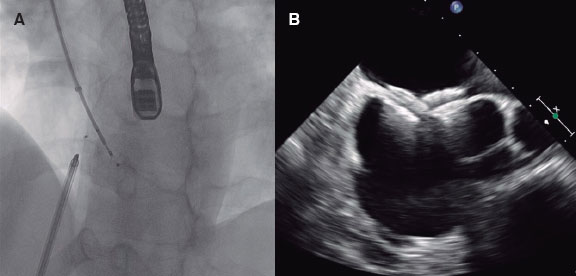Last year’s Editor’s page discussed the emerging quality of our publication that celebrated its first anniversary at that time. Also, the fast and effective response of the journal at the early and confusing times of the COVID-19 crisis should be noted, publishing—in record time—consensus documents written by the Interventional Cardiology Association of the Spanish Society of Cardiology (ACI-SEC) in collaboration with other medical societies. A clear example of this was the article describing the effects of the COVID-19 pandemic on the healthcare situation in interventional cardiology in Spain that has been cited numerous times in some of today’s most prestigious medical journals.1
Over the last year, special articles elaborated by the ACI-SEC or by some of its working groups have been published such as “Update on requirements and equipment in interventional cardiology”,2 and the article on the assessment of endothelial function and spasm provocation test.3 Both documents are of great interest to the entire cardiovascular community, not only from the clinical but also from the administrative point of view.
The main protagonists of such a satisfactory trajectory have been the authors, both those who have submitted their manuscripts in different formats as well as those invited by the editorial committee to write reviews, editorial comments, debate articles, case comments, clinical trial reviews or news on innovation and technology. Some of these guest authors are nationally and internationally acclaimed experts such as Elazer R. Edelman, Juan F. Granada, Hector Garcia, Bruno Scheller, David Adlam, Nico H.J. Pijls, David Erlinge, and Sanjit S. Jolly, among others.
And if the authors are the most important pieces of our puzzle, our reviewers surely follow as they unselfishly dedicate their time and effort to write very high-quality reviews with exceptional turnaround times.
WHAT DID WE ACCOMPLISH AND CHANGE OVER THE LAST YEAR?
This past year, several milestones have been achieved and changes have been made to improve the performance of the journal whilst essential characteristics have been maintained, like its totally free-of-charge/open-access nature, and bilingual publication (in Spanish and English) followed by an optimal presentation both in the online version and in the limited print edition.
Figure 1 shows many of the changes and advances made along the way to achieve public and institutional recognition in the last year. Over the last 12 months, the process of indexing REC: Interventional Cardiology was started. The first milestone in this regard came with the indexation of the journal in the Directory of Open Access Journals (DOAJ), a key player among open-access publications for its quality standards and whose evaluation contributed to improve our journal. Other relevant databases like Scopus, Latindex, and Dialnet followed. Currently, REC: Interventional Cardiology is in the evaluation stages in the SciELO, and Embase databases. We should be hearing from them within the next few months. Also, we expect to be accepted by the Committee on Publication Ethics (COPE) shortly.
Figure 1. Changes and advances made over the last year.
From the editorial point of view, we have systematized how authors declare the study’s ethics committee approval and the availability of patients’/volunteers’ informed consent. In response to the publication demand received, the number of images and letters has gone up to 3 and 4 per issue, respectively. Also, the spontaneous submission of review articles is now possible. In addition, it was decided to eliminate the “clinical trial review” section due to the huge editorial complexity involved in the publication of these articles in a timely manner.
The number of awards for the best articles of the year has been increased - from 2021, we will grant a first prize, €1500 euros, and a second prize, €1000 euros.)
EDITORIAL ACTIVITY
We will now present the activity of the journal until the present time (data from the period that goes from July 2020 through June 2021).
Firstly, the content published between 2019 and 2020 has increased by 36% (from 55 to 75 manuscripts) as show in Figure 2. This increase has occurred in almost all the article formats published in the journal. It was also very satisfactory to publish for the first time the abstracts of the ACI-SEC congress.4,5 This year’s congress abstracts will also be included in the last issue of 2021.
Figure 2. Overall contents published in 2019 and 2020. Abstracts from congresses are counted as 1 unit although a total of 24 abstracts were included. Each clinical case is counted as 3 units since each clinical case includes 3 independent articles: Case presentation, How would I approach it?, and Case resolution.
Another rewarding aspect is the international origin of some of the articles submitted. Up to 17% of these manuscripts came from 14 different nationalities, especially from Latin American countries. Most manuscripts are submitted in Spanish, which does not necessarily indicate their origin, but submissions in English are increasing (Figure 3).
Figure 3. A: language of the manuscripts received. B: origin of the manuscripts received. * Data from 2021 include the first and second quarter of the year only.
Original articles
Between the second semester of 2020 and the first semester of 2021 a total of 25 original articles were received without significant variations among the different quarters of the year (Figure 3). Within the same period, a total of 14 original articles were accepted for publication (52.8%).
The number of manuscripts received since the the launch of the journal has also gone up; we believe that the tendency of 2021 should be similar to that seen in 2020. As a matter of fact, we anticipate the submission of more than 30 original papers (Figure 4).
Figure 4. Original articles received since the journal was launched until June 30, 2021, by quarters of the year.
Currently, our main objective is to increase the number of original articles, which is why we invite the community of interventional cardiologists to submit research papers. In return, REC: Interventional Cardiology offers a fast high-quality peer-review process, and maximum exposure of the papers published.
Letters to the Editor
Between July 2020 and June 2021, a total of 16 letters were submitted (Figure 5), 70% of which were accepted for publication.
Figure 5. Letters to the Editor received since the journal was launched until June 30, 2021, by quarters of the year.
Most of them were received during the third quarter of 2020. However, the number of letters received dropped later (Figure 5), a trend also seen in the clinical cases (Figure 6) and images in cardiology sections (Figure 7). In all cases, the quarterly nature of the journal allowed to complete this content several issues in advance. The editorial committee publicised the situation, which discouraged some authors from submitting articles to these sections.
Figure 6. Clinical cases received since the journal was launched until June 30, 2021, by quarters of the year.
Figure 7. Images received since the journal was launched until June 30, 2021, by quarters of the year.
Although the space available for letters has been increased (up to 4 since the last issue of 2020), we still need to find a breakeven point by securing a constant publication demand without generating a large stock whose content could lose momentum regarding print publication.
Clinical cases
As previously mentioned, clinical cases experienced a situation similar to that of the letters: an increase in reception during 2019-2020 was followed by a decrease in 2021 (Figure 6).
The explanation seems to be the same. Only 1 case is published per issue—4 cases throughout the natural year—which significantly limits the capacity of acceptance. The stock of cases forced us to be highly restrictive as well, and only 2 of the 6 cases received within the same period were accepted, somehow discouraging submission.
Images in cardiology
In the interannual period covered by this analysis a total of 18 images were received (Figure 7), but only 7 were accepted for publication. The evolution of this type of content is very similar to that of cases and letters: the stock of images pending publication limits the possibility of acceptance, thus discouraging submission. Given these circumstances, over the last year the number of images published per issue was increased from 2 to 3.
CONTENTS TRANSFERRED FROM revista española de cardiología
Our flagship publication, Revista Española de Cardiología, has a high impact factor, making it highly attractive for researchers worldwide. This creates an inevitable mismatch between the number of manuscripts received and the number of manuscripts accepted, setting the bar of article rejection quite high despite the undeniable interest of many of the manuscripts. REC: Interventional Cardiology’s editorial committee evaluates rejected manuscripts within the scope of the journal and offers the authors the possibility of submitting them to our journal.
Over the last interannual period, the authors of 14 manuscripts accepted this referral proposal. We strongly believe that, in time, this alternative will become more attractive and accepted.
THE AUTHORS
The editorial committee wishes to take a moment to write a few words of gratitude to the true architects of this journal, those who have made it possible: the authors of the contents. Our journal is still in its infancy and cannot offer an impact factor to those researchers who decide to publish with us. That is why their contribution is especially appreciated, because it elevates the journal to quality levels that will bring the impact it truly deserves.
This gratitude is not only applicable to the authors who submit their manuscripts spontaneously, but also to those who accept the invitation of the editorial committee to elaborate top quality commissioned contents.
THE REVIEWERS
Last year’s Editor’s page already discussed the praiseworthy work of our reviewers for their positive response and speedy delivery of their very high-quality evaluations. This year we wish to bring it up again as their response has been the same. Figure 8 includes the evaluation times, and the editorial decision-making times. The performance of our reviewers is simply exceptional. It only takes them an average 8.8 days to evaluate all kinds of contents, and a little over 10.1 days to evaluate original articles. Compared to other journals outside the REC Publications journal family, this is truly remarkable.
Figure 8. Mean editorial times from July 1, 2020 through June 30, 2021. The mean values reported correspond to 90 evaluations of any type (38 evaluations of original articles).
For all this, we think all reviewers should be congratulated on their work (table 1). Also, our elite reviewers deserve special credit due to their exceptional evaluations and fast-track responses (table 2). Their work is recognized with CASEC credits.
Table 1. Reviewers of REC: Interventional Cardiology who performed evaluations from July 1, 2020 through June 30, 2021
| Juan H. Alonso-Briales |
| Ignacio Amat |
| Eduardo Arroyo |
| Dabit Arzamendi |
| Pablo Avanzas |
| Teresa Bastante |
| Salvatore Brugaletta |
| Ramón Calviño |
| Xavier Carrillo |
| Belén Cid |
| Bernardo Cortese |
| Ignacio Cruz |
| Javier Cuesta |
| José F. Díaz |
| Jaime Elízaga |
| Rodrigo Estévez-Loureiro |
| José L. Ferreiro |
| Xavier Freixa |
| Guillermo Galeote |
| Tamara García-Camarero |
| Bruno García del Blanco |
| Javier Goicolea |
| Joan A. Gómez-Hospital |
| Josep Gómez-Lara |
| Nieves Gonzalo |
| Enrique Gutiérrez-Ibañes |
| Felipe Hernández |
| Andrés Íñiguez |
| Santiago Jiménez-Valero |
| Alfonso Jurado |
| Esteban López de Sá |
| José R. López-Mínguez |
| Ramón López-Palop |
| Íñigo Lozano |
| Cesar Morís |
| Soledad Ojeda |
| Manuel Pan |
| Armando Pérez de Prado |
| Fernando Rivero |
| Oriol Rodríguez |
| Rafael Romaguera |
| Juan M. Ruiz-Nodar |
| José R. Rumoroso |
| Manel Sabaté |
| Ángel Sánchez-Recalde |
| Ramiro Trillo |
Table 2. Elite reviewers in 2020
| Pablo Avanzas |
| Salvatore Brugaletta |
| Javier Goicolea |
| Joan A. Gómez-Hospital |
| Felipe Hernández |
| Santiago Jiménez Valero |
| Alfonso Jurado-Román |
| Ramón López-Palop |
| Manuel Pan |
| Fernando Rivero |
| Juan M. Ruiz-Nodar |
OUR WEBSITE
Despite our limited print edition, the dissemination of the journal’s content in this digital age is predominantly online. The main incoming traffic to our website6 is organic traffic that grows parallel to the indexing of our contents in database search engines, followed by direct traffic and accesses from other sites: the SEC website,7 ACI-SEC official website,8 where the journal has gained visibility, Revista Española de Cardiología,9 REC: CardioClinics,10 Google Scholar,11 Campus IMAS,12 websites, etc.
We wish to take this opportunity to thank all Latin American scientific societies that have included a hyperlink to our journal in their official websites.
Our journal is read all over the world. The highest number of visits come from Spain, followed by the United States, Mexico, Argentina, and India (Figure 9).
Figure 9. Visits to the electronic edition of REC: Interventional Cardiology from July 1 2020 through June 30, 2021.
Regarding social networks, Twitter is our main source of traffic (62%) followed by Facebook (28%), Instagram (5%), and LinkedIn (2%).
Our homepage, ahead-of-print contents, abstracts, and COVID-19-related contents have been quite visited. Also, we should mention the interest generated by contents such as the special article on the percutaneous management of tricuspid regurgitation, or the review article on TAVI in special indications.13,14
Between the end of 2020 and the beginning of 2021, our publishing house, Permanyer Publications Ltd., updated the journal website6 several times to make it more stable and lay the foundations for its future growth. The site design has not changed since most of these changes are invisible to the user. However, they improve the user navigation experience allowing new possibilities for the growing volume of contents in our journal.
DISSEMINATION
The journal’s Editor’s videos15 with author interviews, were consolidated over the last year. Thanks to streaming recordings, the difficulties following the lack of mobility due to the pandemic were overcome. We became more familiar with a new recording format that allows more flexibility and dynamism. Several authors have expressed their appreciation and surprise for the unexpected peaks of visibility that these videos had had for their articles among our scientific community.
In addition, newsletters with a summary of the latest issue published are sent to our subscribers quarterly. The bulletins sent by Revista Española de Cardiología include a hyperlink to our contents too. Also, the latest articles published on REC: Interventional Cardiology can be found on Revista Española de Cardiología’s website.
Interviews with the authors of our articles are regularly published in the blog Cardiología Hoy16 on the SEC website. Also, different access windows have become available for the users (homepage, publications section, etc.). REC: Interventional Cardiology’s articles are disseminated through SEC bulletins. In addition, our journal has its own specific space on SEC News.
REC Interventional Cardiology was also present in discussion forums specifically created for our journal in congresses and scientific meetings held over the last year in Latin American countries, namely Mexico and Venezuela.
AWARD TO THE BEST ARTICLE PUBLISHED ON REC: Interventional Cardiology
As with all our activities, the initiatives to disseminate our journal have been influenced by the COVID-19 pandemic. The first-edition award for the best article published on REC: Interventional Cardiology went to “Quantitative flow ratio in myocardial infarction for the evaluation of non-infarct-related arteries. The QIMERA pilot study”.17 The prize was awarded during the 31st ACI-SEC Congress that was held virtually in 2020. For the second edition, the ACI-SEC has decided to increase the reward and number of prizes awarded to 2 (an overall prize of €2500; first prize, €1500; second prize, €1000).
The COVID-19 year changed the world overnight. Big –and in many cases permanent– changes have occurred. Our journal knew how to face this historic crisis and came up strong. As we mentioned earlier, the trajectory of REC: Interventional Cardiology keeps consolidating, growing, and improving to achieve higher levels of recognition. It is the culmination of a dream that a group of Spanish interventional cardiologists had for years. A dream that has become an unquestionable reality today.
ACKNOWLEDGMENTS
So far we have shown our appreciation to authors and reviewers alike for their essential role in our journal. As the editor-in-chief, I also wish to show my profound gratitude for the work done by associated editors Dr. Juan Sanchis, Dr. Fernando Alfonso, and Dr. Raúl Moreno.
Dr. Juan Sanchis has become the editor-in-chief of Revista Española de Cardiología, which is a guarantee of success in the future of this publication.
For the last 2 years, Dr. Raúl Moreno has been a member of the editorial team, and the president of ACI-SEC. The incoming new president, Dr. Ignacio Cruz, will also be one of the main pillars of the journal. We should remember that the ACI-SEC is the leading sponsor of our journal, which is essential to guarantee its viability. And speaking of funding, we wish to thank the contribution made from companies in the interventional cardiology field. Thanks to their unconditional co-sponsoring our journal has come to life as ackowledged in the back cover of every issue.
Finally, we wish to express our gratitude to the members of Revista Española de Cardiología editorial office including Iria del Río, Eva M. Cardenal, Belén Juan, María González Nogal, and Helena Gómez Lobo, TIC consultant Pablo Avanzas, the SEC TIC working group, and the entire team at Permanyer Publications Ltd. for their excellent work and dedication. The enthusiasm shown at the beginning has not wavered and is now stronger than ever.
The dedication and devotion of all these people have been unconditional and remain an ongoing stimulus for this editorial team.
“To be perfect is to have changed often”
J.H. Newman
FUNDING
None declared.
CONFLICTS OF INTEREST
None reported.
REFERENCES
1. Rodríguez-Leor O, Cid-Álvarez B, Ojeda S, et al. Impact of the COVID-19 pandemic on interventional cardiology activity in Spain. REC Interv Cardiol. 2020;2:82-89.
2. Moreno R, Ojeda S, Romaguera R, et al. Update on requirements and equipment in interventional cardiology. Consensus document by the Interventional Cardiology Association and the Ischemic Heart Disease and Acute Cardiac Care Association of the Spanish Society of Cardiology and the Spanish Association of Nursing in Cardiology. REC Interv Cardiol. 2021;3:33-44.
3. Gutiérrez E, Gómez-Lara J, Escaned J, et al. Assessment of the endothelial function and spasm provocation test performed by intracoronary infusion of acetylcholine. Technical report from the ACI-SEC. REC Interv Cardiol. 2021. https://doi.org/10.24875/RECIC.M21000211.
4. Resúmenes presentados al 31 Congreso de la Asociación de Cardiología Intervencionista de la Sociedad Española de Cardiología 2020. REC Interv Cardiol. 2020;2:315-323.
5. Resúmenes presentados al 31 Congreso de la Asociación de Cardiología Intervencionista de la Sociedad Española de Cardiología 2020 (II). REC Interv Cardiol. 2021;3:C1-C5.
6. REC:Interventional Cardiology. Available at:https://recintervcardiol.org/en. Accessed 1 Jul 2021.
7. Sociedad Española de Cardiología. Available at:https://www.secardiologia.es. Accessed 1 Jul 2021.
8. Asociación de Cardiología Intervencionista de la Sociedad Española de Cardiología (ACI-SEC). Available at:http://www.hemodinamica.com. Accessed 1 Jul 2021.
9. Revista Española de Cardiología. Available at:http://www.revespcardiol.org. Accessed 1 Jul 2021.
10. REC:CardioClinics. Available at:http://www.reccardioclinics.org. Accessed 1 Jul 2021.
11. Google Scholar. Available at:https://scholar.google.com/. Accessed 1 Jul 2021.
12. Campus IMAS. Available at:https://campus.imasfundacion.es/. Accessed 1 Jul 2021.
13. Moñivas Palomero V, Mingo Santos S, Li CH, et al. Percutaneous management of tricuspid regurgitation. Image-guided step-by-step MitraClip procedure. REC Interv Cardiol. 2020;2:118-128.
14. Amat-Santos I, Santos-Martínez S. Specific indications for TAVI. REC Interv Cardiol. 2020;2:206-214.
15. Vídeos del Editor REC:Interventional Cardiology. Available at:https://recintervcardiol.org/es/videos-del-editor/. Accessed 1 Jul 2021.
16. Blog REC Interventional Cardiology. Available at:https://secardiologia.es/blog/rec-interventional-cardiology. Accessed 1 Jul 2021.
17. Cortés C, Rodríguez-Gabella T, Gutiérrez H, et al. Quantitative flow ratio in myocardial infarction for the evaluation of non-infarct-related arteries. The QIMERA pilot study. REC Interv Cardiol. 2019;1:13-20.
* Corresponding author: REC: Interventional Cardiology, Ntra. Sra. de Guadalupe 5, 28028 Madrid, Spain.
E-mail address: rec@intervcardiol.org (J.M. de la Torre-Hernández).


